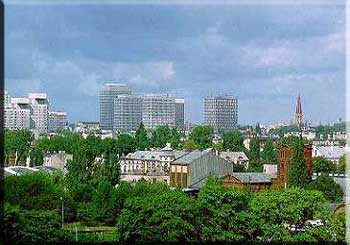Vacation Packages
Lodz vacation packages
lodz Hotels
- Lodz luxury hotels 5*:
- Lodz first class hotels 4*:
- Lodz budget hotels 3*:
- Selection of gut rated hotels in Lodz:
The town of Lowicz was founded in the 12th Century. For six hundred years it was home to the archbishops of Gniezno, Poland's religious leaders. Today the town is known for being the center of folk arts and crafts for the surrounding region, including weaving and wood carving.

Lodz vacation packages

The first mentions of Lodz date back to 1332. In July 1423 Lodz was granted its municipal privilege by king Wladyslaw Jagiello. At that time Lodz had got a 28-cornfield area. The existence of its inhabitants was based on agriculture. This period of its history is called the period of "The agricultural Lodz". In the middle of the 16th century the population of the town was 650-800.
At the beginning of the 19th century the period of prosperity begins. The new inhabitants, craftsmen, and merchants are coming to Lodz, the markets and town fairs come to life. The history of great career of Lodz started in the first half of the 19th century. The customs border between the Polish Kingdom and Russia was lifted. The domestic textile industry came into being and Lodz started to be the leading centre of Polish textile industry.
The founder and patron of modern Lodz was Rajmund Rembielinski. Owing to his efforts, in 1820 Lodz was ranked among the so called "factory cities". The first settlers came to the town in 1822. In 8 years time there were more than a thousand families of craftsmen in Lodz. They gave rise to the development of textile industry in the town.
IMAGE:The first textile settlement in Lodz. "The Textile New Town" originated in 1823. That date is considered to be the beginning of "the industrial Lodz". Lodz becomes "The Promised Land" for thousands of poor people from villages and small towns. From the village hidden among willow-osier, out of swamp and peatbog, the town started to emerge.
Only half of the century passed from the beginning of the town to the times when industrial Lodz started to flourish. Already in 1825 the first cotton mill, built by Kristian Fryderyk Wendisch coming from Saxony, was started. In 1839 in L. Geyer's factory the first steam-engine in Polish cotton industry was installed. In 1855 in K. Scheibler's factory the spinning machine was started, and in 1866 in J. Heinzl's factory the first weaving-mill.
The very fast increase in population of Lodz in the 19th century was a result of the immigration from villages and small towns. The settlers from adjoining countries, mainly from Czech and Saxony, but sporadically also from England, France and Switzerland, were flowing into Lodz. As far as the increase rate in population is concerned, Lodz broke all records of that time. Almost every 10 years the population of Lodz was doubling (in 1860 it was 32 000, and in 1897 - 314 000). In the years 1828-1880, Lodz underwent enormous changes. After that period it entered a phase of fast growth, concentration of capital and the rise of production.

Lowicz's regional museum contains folk art as well as the history of the town and the archeology of the region. The Kolegiata, or Collegiate Church, is an interesting blend of the Gothic, Renaissance, and Baroque styles. Nobel Prize winner Wladyslaw Reymont's 1924 novel Chlopi (The Peasants) was set in this area. Lodz is the second largest city in Poland and is primarily an industrial town. In the 1800's, Poland's government chose Lodz as the country's new textile center in an attempt to industrialize the nation. By WW I, the town had a population of a half million as Poles came here to work in the textile industry. Today Lodz is still Poland's textile capital. It is also Poland's Hollywood with several film schools and studios, including the Film Academy of Poland. Lodz's Jewish cemetery was founded in 1892 is the largest in all of Europe.
Although of old tradition (the village of Lodzia was first mentioned in 1332 documents), it is a relatively young, nineteenth century town. A center of textile industry, until recently its landscape was dominated by smoldering smoke-stacks. Now a vibrant city, soon to be transformed into a trade capital of Poland.
The Museum Sztuki (Museum of Art) in Lodz is one of the oldest museums of modern art in Europe. Its essence is the unique International Collection of modern Art. Covering the period from 1920s the collection of world modern art is gathered, the stimulus once given by a group of artists with Wladyslaw Strzeminski - painter, art theoretician, animator of the avant-garde movement, Katarzyna Kobro - sculptress and Henryk Stazewski - painter. Their guiding principle was to create the International Collection of the Contemporary Art.
Tags: Lodz travel guide, vacation rentals, hotels, package holidays, points of interest, car rental, city breaks, weather